Advertisement - Click to support our sponsors.

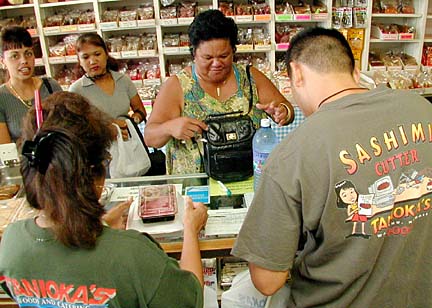
When Oahu's only fish auction begins at 5:30 a.m., Cliff Yamauchi, seafood manager of Tanioka's Seafoods and Catering, is there -- inspecting firmness and color of the day's bigeye tuna. THE TASTE FOR TUNA
Fresh fish
The cost of the catch
daily fare for
many residents
By Rosemarie Bernardo
Star-BulletinMuch of the fish sold daily at Tanioka's is sold for raw consumption as sashimi or poke, so freshness is key. "Our clientele likes the red meat fish," says Yamauchi. "We strive for better quality, because our customers expect it from us."
With his gloved left hand, Yamauchi pulls out a sample chunk of fish meat. Unsatisfied with the quality of the ahi brought in by only longline boat selling fish today, Yamauchi instead buys 1,230 pounds of aku (skipjack tuna) and a 155-pound ahi (yellow fin tuna) caught by aku boats and trawlers.
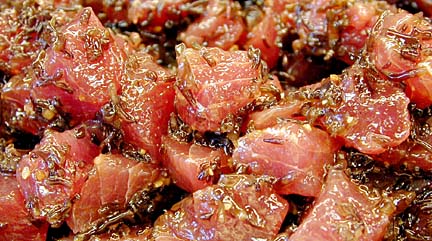
It takes 20 minutes to drive the day's "catch" to the store in Waipahu, where employees are ready to cut it for sale.With a foot-long knife, seafood assistant manager Baron Miho takes an aku and makes three slits around the head to remove it. Nothing is wasted here -- the fishhead and tails are saved for crabbers who use it for bait.
From the tail, Miho runs the knife through the middle of the aku cutting it into two pieces. Some of the aku is given to the store's sashimi and poke cutters, who cut it into thin slices or cubes, respectively.
With daily sales ranging from 500 to 2,000 pounds, Tanioka's is but one of the many places in Hawaii where people buy fresh fish. Anywhere from 5,000 to 175,000 pounds of fish are sold daily in Hawaii -- about 60 percent for local consumption and the rest for export. Wearing a white plastic apron, sashimi cutter Richard Mitsuyoshi takes a long strip of aku and carefully cuts it into thin slices.
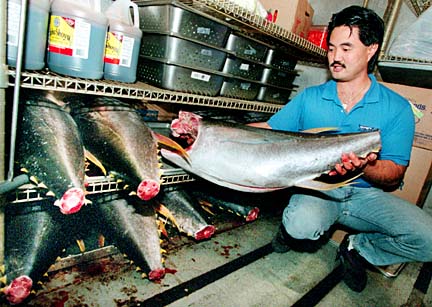
Mitsuyoshi slides his knife under the aku pieces and transfers 18 slices into a small bento box. Between 100 to 400 pounds of fish are cut for sashimi daily at Tanioka's. About five pounds of fish are pre-measured for each batch of the eight varieties of fish poke sold at Tanioka's. Between 500 to 1,000 pounds of fish are used daily for poke.At 11 a.m., customers begin to stream through the front glass doors of of the shop and owner Mel Tanioka talks to many of them. On Saturdays, the line often winds out the door.
"We have a lot of regular customers. They're like family to us," he says.
He greets Gina Costales, waiting to pay for a pound of lomi ahi, with a friendly, "Howzit, how are you?" Costales has been coming to Tanioka's since she was a child.
Since Tanioka opened the store in 1978, he's made it a habit to pass out candy to customers' kids. Now that some of those former kids are buying poke for their own children, "it makes me feel old," laughs Tanioka.
The store at 94-903 Farrington Highway is definitely a family affair. Tanioka's wife Lynn, children Jasmine and Justin, and mother-in-law Thelma Furukawa all work in the store. And Yamauchi is Tanioka's nephew.
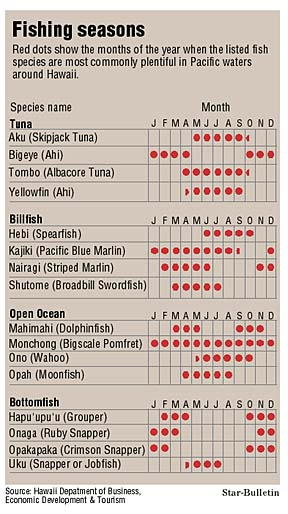
Royal Kunia resident Justin Goo buys a pound each of limu poke and tako poke. "I eat fish every day," says Goo. Like many customers, Goo is wondering whether a federal judge's plans to severely limit longline fishing beginning August 25 might drastically decrease the amount of fresh ahi available -- and drive up its price.Former longline fisherman Mark Nakeshima has a plan if that happens: "Instead of one pound, I'll buy half-a-pound."
Yamauchi worries that if longliners are severely curtailed that "no one will be able to afford fresh tuna in Hawaii" and the quality will go down.
"Who will buy poke at $20 a pound," he asks. "I honestly wouldn't buy it at that price."
Yamauchi says he can see 50 to 70 percent of fish-related businesses going out of business. "Hawaii's going to really hurt."
"The auction and the longliners will be affected the most," if fishing is reduced, says Yamauchi. "From there, it will trickle down to everyone that's affiliated with the auction. It's a chain reaction.
"For the turtles (on whose behalf the longlining is being restricted), I believe they should be able to swim freely," he says. "But, I'm not sure the environmentalists are targeting the right people. They're blaming the longliners for things that may or may not be happening as much as they fear they are."
Perhaps the best recommendation a fish market can offer its customers is the fact that its employees eat what it sells.
Tanioka himself eats sashimi almost every day and has the motto: "I wouldn't serve a poke that I wouldn't eat."
United Fishing Agency, Oahu's only fish auction, sells the bulk of fresh fish caught in Hawaiian waters each day. On a recent day in July, the auction sold 70,811 pounds of fish, at a total wholesale price of $168,861. Here's the breakdown by: The cost of the catch
Tuna

TYPE POUNDS TOP AUCTION TOP RETAIL SOLD PRICE PRICE Bigeye ahi 11,166 $6.90 $21.99* Yellowfin 4,582 $5.70 $16.99* Aku 17,186 $1.50 $6.99 Tombo 3,010 $2.80 $8.99
Billfish

TYPE POUNDS TOP AUCTION TOP RETAIL SOLD PRICE PRICE Shutome 20,711 $5.00 $8.99 Striped marlin 1,105 $2.40 $7.99 Blue marlin 2,521 $1.80 $6.99 Hebi 225 $1.80 $4.99
Open ocean

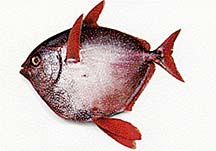
Opah (moonfish)

Ono (wahoo)
TYPE POUNDS TOP AUCTION TOP RETAIL SOLD PRICE PRICE Mahimahi 5,802 $3.50 $10.99 Monchong 389 $2.30 $9.99 Ono 849 $3.40 $11.99 Opah 1,194 $2.40 $8.99
Price at auction on July 18. Price depends on quality of fish. Price at ratail stores on July 25. All prices for fillets, except those marked with an asterisk (*), which are sashimi prices. Source: United Fish Agency and retail stores Foodland, Safeway, Star and Times.